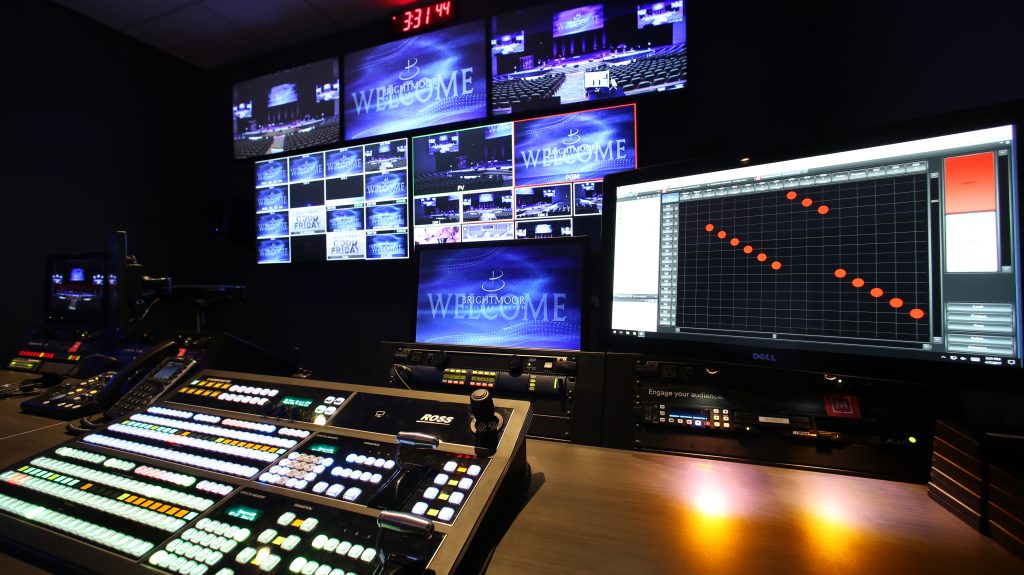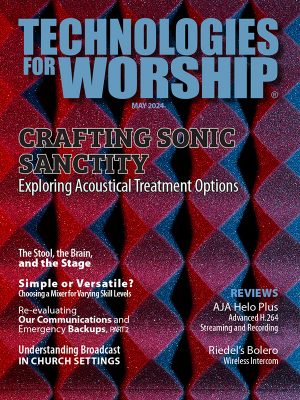
by James Careless
Churches who broadcast and/or stream their services to TV viewers need to keep up with the times. Standard definition (SD) narrow screen (4:3) video won’t hold the attention of today’s viewers who are accustomed to HD and 4K. This is why churches who are still using SD equipment (and in some cases, widescreen HD as well) need to consider transitioning their broadcast workflows (equipment, production methods, and content) to a more modern standard.
At the same time, money doesn’t grow on trees for most churches, so upgrading their broadcast workflow more than unnecessary can be a financial mistake. Here’s how to determine what your church needs to do, and how to do it.
Who Is Being Served?
The key to an audience-appropriate, fiscally intelligent workflow upgrade is for church leadership to answer the following question: Why are we serving by doing this?
The right answer to this question isn’t because the church’s existing broadcast plant is falling apart. “Even failing equipment isn’t a good excuse to perform a major HD or 4K upgrade,” said Jon Ackerman, Mankin Media Systems’ Communications Director and Solutions. “Instead, your vision should be tied to how your church’s mission is being hindered because of the equipment you are currently using.”
The scope of this vision governs what degree of broadcast workflow should be chosen. For instance, if the church relies solely on Facebook and/or YouTube to deliver video via streaming, “there may be no point in upgrading beyond 720p,” said Jon Pettifer, Account Manager at Digital Edge Media. “Both of these platforms typically limit their streams at this resolution because of bandwidth reasons. So even if you produce in 4K, what your viewers may see will be at lower resolution 720p HD.”
4K is a Big Leap
For large and mega-churches whose aging broadcast workflows are due for replacement, there can be advantages to adopting 4K. Chief among these is enhanced image quality for in-church viewing, because 4K provides four times the resolution of 1080p HDTV. When a church’s monitors, projector screens, and video walls need to be massive, 4K is the way to deliver highly detailed and viewable images to everyone in the building. Meanwhile, if the broadcast channel(s) carrying these services to the world are also 4K-capable, then upgrading the broadcast workflow to meet this standard now can make a lot of sense.
The downside to this big leap is price. “If a venue wants to display 4K video and/or images, then the commitment for every piece of the chain to be 4K capable is imperative,” said Mike Robertson, CTS National Sales Consultant with CCI Solutions. “This includes the source, cables, converters, video and/or image sources and destination displays such as projectors and TVs. Meanwhile, when considering HD or 4K for streaming, part of this process is knowing what kind of bandwidth you have to work with. Larger file sizes will demand more bandwidth to upload your video.”
This is why Robertson urges churches to think long and hard before choosing 4K over HD. “Do the people in your venue need to see 4K?,” he asked. “Is there a benefit to display 4K vs standard HD? In many cases, standard HD typically ends up being the answer to this question as the cost to update the entire chain is much less expensive.”
Is Piecemeal Possible?
Executing a broadcast transition on a piecemeal basis – changing out some components now and others later – can be an attractive option for cash-strapped churches. Theoretically this option is doable if the new video switcher and signal router are ‘backwards compatible’, such as a 4K switcher that can accept HD camera inputs.
On the flip side, using a piecemeal approach means that the benefits of upgrading to, say, HD to 4K will only be realized after the entire production chain has been raised to this standard. If the cameras are still HD, then the final output will be HD (or HD upconverted to 4K), not true 4K. If the displays are HD, then 4K won’t be showing up on them either..
Worth noting: “You can almost always combine a discrete piece of gear with a converter to make it work with your current system,” said Ackerman. “Decimator, Cobalt, Ross, and Black Magic Design all make ‘throwdown converters’ to take a video signal and convert it to something else. Will it be elegant? No. Will it cause a few frames of latency in your video signal? Yes.”
“If you do it in the right order and with a clear eye on your end goal, you can get away with piecemealing,” Pettifer said. “But you have to do it with an overall plan in place, so that you’re always working towards your goal, not against it.”
When to Call a Pro
It can be expensive to transition a broadcast workflow, whether the upgrades are done all at once or piecemeal. Add the high visibility of such projects to church leadership, and one can see why calling in a professional integrator to handle it all makes good sense.
If not, “the best approach if doing this DIY is to first create a detailed plan,” said Robertson. “Look through the design thoroughly and account for any conversions and or breaks in the signal flow from start to finish. Second, plan on purchasing all the gear upfront, so that everything is available when it’s time to install. And third, schedule the time appropriately for the space. Give yourself more time than you think is needed to run that certain cable, because you will hit a snag that will slow the process.”
The Bottom Line
It is possible to optimize the broadcast transitioning process through clear vision, detailed budgetary and integration planning, appropriate equipment selections, and realistic deadlines.
When done properly, moving a broadcast workflow from SD to HD/4K or HD to 4K can be relatively painless, and the results can be stunning. But if the process is rushed, poorly planned, and/or done too quickly, the outcomes can include interrupted broadcast production, recurrent technical issues, and unhappy church leadership.
James Careless is an experienced freelance writer with credits at The Toronto Star, National Post, and Globe and Mail newspapers. He is also a broadcaster/podcaster and has produced the ecumenical radio show “Daybreak” at CHEX-AM radio in Peterborough, Ontario.


